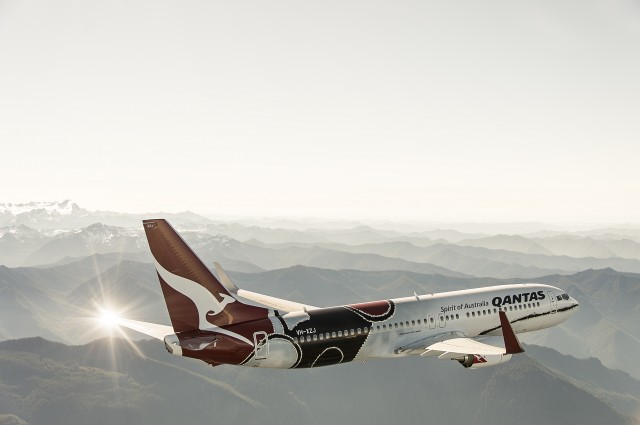
Qantas’s newest Flying Art livery ’œMendoowoorrji’ – Photo: Qantas
Qantas Airways recently took delivery of the fourth, and latest, aircraft in it’s Aboriginal ’œFlying Art’ livery after an unveiling in Seattle.
Qantas has long had a tradition of special liveries depicting numerous special events, but the ’œFlying Art’ series is iconic and unique to Qantas. Starting in 1993, to celebrate the International Year of Indigenous People, the first Qantas aircraft to get the special treatment was a 747-400 entitled ’œWunala Dreaming’.
The design was meant to represent kangaroos and the red outback landscape (wunala is aboriginal for kangaroo) and became the most famous of the liveries; so much so that when the first aircraft to wear the livery, VH-OJB, was due for refit, it was moved to a new 747-400ER (VH-OEJ).
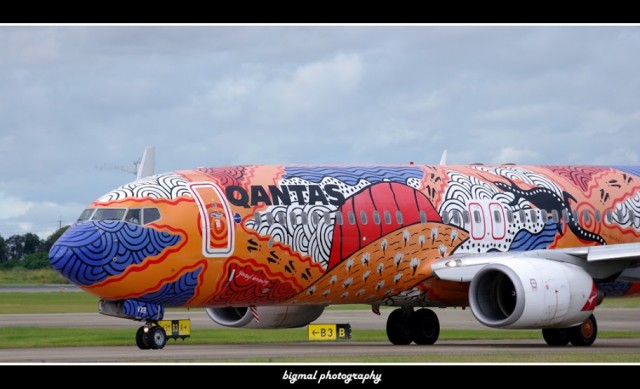
The only other still-flying piece of Qantas Aboriginal art is “Yananyi Dreaming” – Photo: Mal Muir
A second 747 got the special treatment in 1995 (this time a 747-300), entitled ’œNalanji Dreaming’ didn’t get as much love as its predecessors; when the -300s left the fleet, the plane was stripped bare at one of the Qantas bases, where it remains to this day awaiting scrapping.
The first domestic aircraft to get a special themed livery, a 737-800, was ’œYananyi Dreaming’ and took it’s first flight in 2002. It has been flying the Australian skies ever since and was the only Flying Art livery flying after Wunala was withdrawn in 2012.
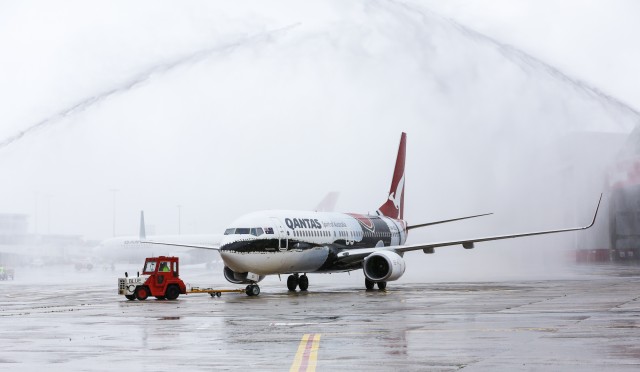
’œMendoowoorrji’ getting a fitting reception in Sydney, receiving a water cannon salute – Photo: Qantas
The latest piece of flying art to join the Qantas fleet is ’œMendoowoorrji’, which is adapted from renowned aboriginal artist Paddy Bedford’s Medicine Pocket. ’œMendoowoorrji’ is the location in the East Kimberley of Western Australia where Paddy Bedford is from and this aircraft is a tribute to not only the artist but the region as well.
’œAs the national carrier, Qantas has a proud history of featuring Indigenous art throughout its fleet and we are pleased to welcome the newest aircraft in our Indigenous flying art series,’ said Qantas CEO Alan Joyce. ’œThe aircraft is a tribute to Aboriginal art and culture and is aimed at promoting cultural diversity and appreciation of Australia’s Indigenous heritage.”
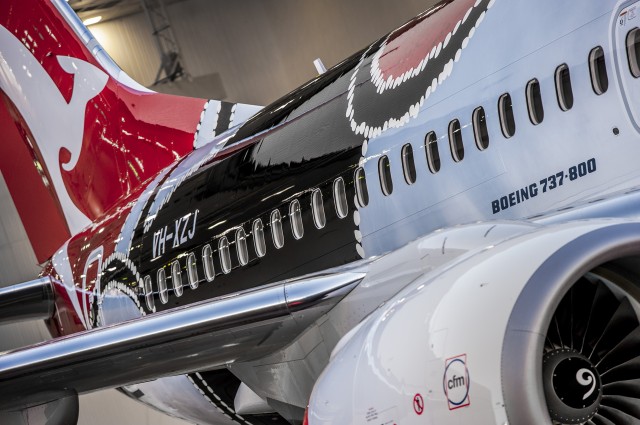
Unless you get up close, you can’t see the detail that went into creating this piece of flying art. What appears white is actually almost blue. – Photo: Qantas
When you look at the aircraft the first time, it may not look like much compared to the previous liveries. In fact the first time I saw it my thoughts were, ’œthat’s a lot of white.’ But Balarinji (the designers of the livery) used this in their design.
The subtlety in the livery is where the uniqueness kicks in. The aircraft has colors and details that the eye can’t see without being up close – the rear markings of the plane are also slightly blue, something you wouldn’t see unless at the right angle.
The biggest change is the incorporation of the livery in the overall design. In the past, the standard Qantas red tail and kangaroo was applied, however this time the red has been adjusted to reflect earthy tones of the artist’s work.
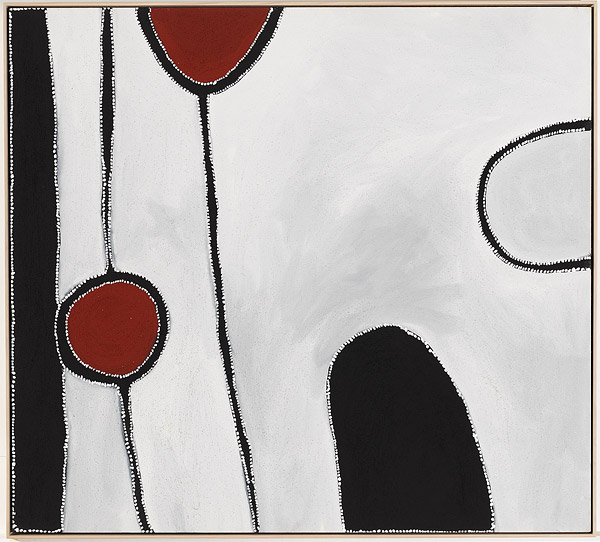
Paddy Bedford’s Medicine Pocket is the inspiration for this unique Qantas Livery – Image: National Gallery of Australia
As with any special livery, opinions will of course be mixed. Personally, I still prefer the original pieces of Wunala or Yananyi. Those aircraft that were essentially my spotting targets for many years while living in Australia.
Managing to get Wunala on its final flight into Brisbane before being repainted was a special day for me, so seeing this new aircraft originally shocked me at how ’œbare’ it looked.
Others have commented that they love the new livery, that the artwork is modern and contemporary, like the artist’s work. That is still can be seen as a Qantas livery and it doesn’t totally dominate the aircraft.
As the aircraft is set to plot its way around Australia, working the domestic routes, many people will see this new distinctive livery. Although it may look similar to the others in the Qantas fleet, like any true piece of art, beauty is in the eye of the beholder.
What do you think?
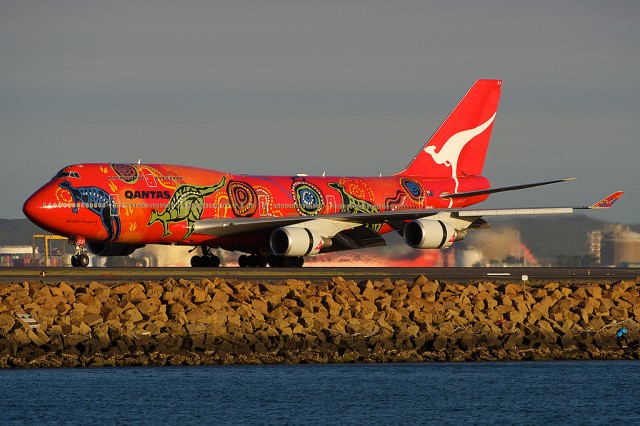
I remember flying on the -300 in March of 1998 I was mesmerized by that aircraft! I’m not sure how I feel about this latest one, but your comment about getting up really close has opened my mind and I cant wait to see it. Thanks Mal!
I thought the same when I saw it the first time as well, the first ever shots just did not do it justice from a distance. It is the really up close pieces that show the detail.
Wonderful extanlapion of facts available here.
I think it is a thing of beauty. May it grace the skies for at least a quarter century!
It’s unfortunate that VH-OEJ was re-painted back to the standard Qantas livery in China in January of 2012. That one was always a fun catch at LAX.
Final departure from Sydney in the ‘Wunala Dreaming’ livery: http://jetphotos.net/viewphoto.php?id=7284836
I managed to get OEJ on it’s final flight into Brisbane a couple of months before I moved over here.
https://picasaweb.google.com/lh/photo/QhjOoVj-b0P17JWEgBQ11NMTjNZETYmyPJy0liipFm0?feat=directlink
Beautiful sight, not that great a day unfortunately 🙁